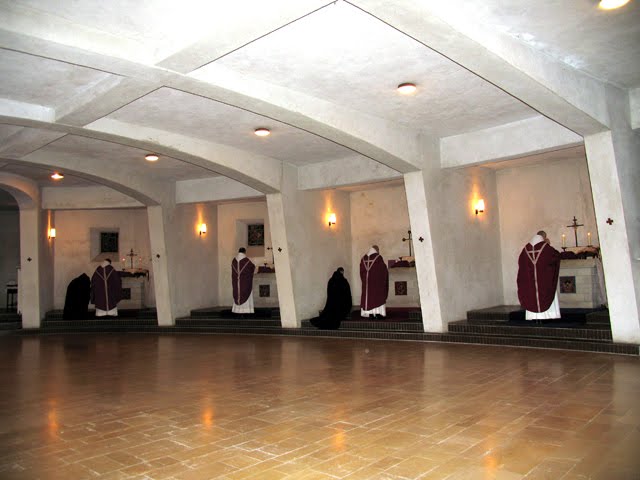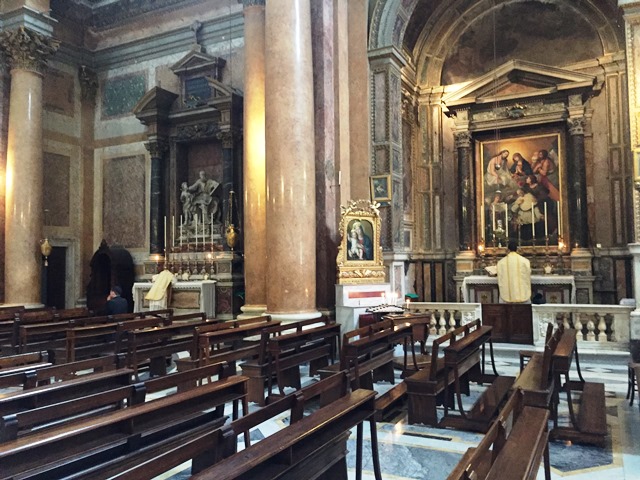From a reader…
QUAERITUR:
Your recent post and “rant” regarding concelebration made me realize…I don’t actually know what happens at a concelebrated Mass. Is it technically two Masses (if there are two concelebrating priests)? How does that actually work?
At first glance, yes, this can be confusing. It seems as if there are as many Masses as their are priests concelebrating. This is especially so because priests are able to accept a stipend even when they concelebrate. Hence, it seems that there are more than one Mass.
However, it’s a philosophical principle that there can be various instrumental causes united under an agent cause. That is, there can be a main celebrant and various concelebrants with their own intentions to apply the merits of the Mass (which are infinite) to this or to that purpose (thus the stipend) but, in fact, at the time of the consecration they all have (we hope) the same intention to consecrate the Eucharist.
Sometimes an analogy of baptism is used. If several priests were to pour water and say the formula of baptism simultaneously over the head of a child, there would be one baptism occurring in the child, not many baptisms.
At a concelebration there is ONE Mass with more than one celebrant,
That said, I think that, as far as the Novus Ordo is concerned, concelebration ought to be safe, legal and rare.
I will concelebrate for, say, an ordination to the priesthood, but not to the diaconate. I won’t concelebrate at weddings and funerals. I am happy to attend in choir. Having clerics in choir also adds to the decorum of the moment.
Concelebration has its place. In the traditional Roman Rite, newly ordained priests each have their own missal and they consecrate with the ordaining bishop. That seems fitting. The rest of the priests present don’t, however. They manifest their unity of priesthood by imposing hands during the rites.
At gatherings of priests, say that a bunch of guys get away at someone’s lake place “up north”, it is tempting to have one concelebrated Mass. It’s “brotherly”, quick, and over. It seems to me better that priests should serve Mass for each other, even if multiple altars must be set up so that it doesn’t take all day (thus, cutting into golf time). It’s good for a priest to serve Mass occasionally.
Frankly… more, reverently offered, Masses are better. How could it not be so?
See my remarks on Save The Liturgy – Save The World.





































I really like that last photo. What was it from?
Chuck4247,you must read ALL of Fr Z’s posts. See his June 9 post.
Good Morning Fr. Z.
Where do we postconciliar converts find information on the way things used to be done (dare I say the right {Rite} way). For example, I recently purchased a Daily Missal 1962 from Baronius Press to help me in my readings of Divine Intimacy by Father Gabriel of St. Mary Magdalen O.C.D., but am sometimes lost on the proper way to use it. Where do I find help with the 1962 Missal and the Traditional Roman Rite? Thank you!
Thank you @acardnal
Maybe it’s because I have never seen a concelebrated Mass get out of hand, but the image of several priests “doing their own thing” like that just seems off-putting to me. I know I am in the minority here, but it makes me think that SOME reforms might have been a good thing…
Kevin: Thanks for asking, though this is not really the topic at hand.
Remember, we don’t want to do what was done before simply because that’s how it was done before. We want to do these things because they work and they were lovingly handed down because they worked. They were polished and decorated and made strong and beautiful for us.
You are on the right track with Divine Intimacy! Also, the Baronius hand missal is lovely.
I suggest that, at first, you sit for a while each day for a short time and explore the hand missal. Get to know it’s layout and contents. Familiarize yourself with it outside of Mass. Then on perhaps Thursday, look up the “proper” prayers for the upcoming Sunday Mass and give them a read through. You could repeat that on the other days before Mass. Then, while you are still getting used to the TLM, rather than try to follow everything in the book as the action of the Mass is ongoing, just take it all in. You’ve already familiarized yourself with the readings and prayers in the days before. Just take it in. Be there. After awhile, it’ll all be clearer how the different elements fit together.
Get to know your book for Mass outside of Mass. Do that first. That’ll help.
Thankfully, concelebrated Masses are rare in our parish. I don’t like concelebration at all, with several priests cluttering up the space around the altar. I wonder what concelebration is supposed to achieve anyway? Is it another symptom of the Novus Ordo tendency for trying to get as many people as possible to be “actively involved”, with lay readers, EMHC’s etc?
A few articles on this topic that readers might find helpful:
http://www.newliturgicalmovement.org/2014/09/celebration-vs-concelebration.html#.XQkWK9I2qUk
http://www.newliturgicalmovement.org/2015/06/book-notice-definitive-study-of.html
http://www.newliturgicalmovement.org/2014/09/concelebration-in-byzantine-rite.html
Lastly, I should note that a chapter in my book “” rel=”noopener” target=”_blank”>Resurgent in the Midst of Crisis” takes up the topic of what has been lost to the Church through exalting concelebration above “private Masses,” and why we should return to that custom, so beautifully displayed in the photos here and elsewhere online.
Fr, I was reading the latest life of Bugnini and was struck by what a big deal the introduction of concelebration was for all those reformists. Why was it so important to them?
On another point, what happens if one of the concelebrants does NOT have the right intentions? Would it invalidate the Mass? If not, a Lutheran could concelebrate with a Catholic, each retaining his own intentions. Is that what the reformists were after?
‘”Maybe it’s because I have never seen a concelebrated Mass get out of hand, but the image of several priests “doing their own thing” like that just seems off-putting to me. I know I am in the minority here, but it makes me think that SOME reforms might have been a good thing…”
Geoffrey: That’s my reaction as well. It seems clear that those simultaneous singly-celebrated Masses are not intended for a congregation, just for the priest, at most with a server assisting. Father Z’s point on concelebration that he has expressed multiple times, seems to be that a concelebration deprives a priest of the privilege and opportunity to offer the sacrifice of the Mass on his own.
As in many other things, there is probably a good middle ground on this issue between the EF and the current OF practice where concelebration may be too readily assumed.
I like the idea of concelebration with the bishop. I detest it in the parish environment where all the concelebrants sit like at my diocesan parish where they have 4 priests and 3 deacons and STILL a horde of extraordinary monsters come out.
Being the ossified manualist that I am, might I take one slight issue with what you’ve said (while not disagreeing with your conclusion).
I would object to taking of stipends for simple concelebration under the understanding that the Mass is of infinite value.
Dusting off my old copy of Fr Nicholas Halligan’s Administration of the Sacraments (1962), I find in there something which makes a great deal of sense. Creatures, he says, are not capable of producing infinite goods, and the Mass is a creature, even though linked to the Cross. “Though the Sacrifice of the Cross is infinite in itself, it remains limited in its application; otherwise all men would be justified and saved, as likewise one Mass would suffice to save the whole world and eliminate Purgatory,” yet the Church’s practice is to repeatedly offer Mass.
And this is why Halligan distinguishes the various fruits of the Mass including the “special or ministerial fruits” which are those which are offered for the intention he makes (based on a stipend or his own pro bono choosing). “The share of each one in these fruits is probably diminished as they are applied to more persons or purposes,” he writes (on p. 131).
Prümmer and Merkelbach seem to agree with Halligan’s assessment in their relevant sections, unless my Latin is not as good as I think it is.
Having studied that, I have never taken a stipend when I have concelebrated Mass, unless the donor was clear that he was okay with this. I am sure that if the Church allows it that one is free to do so, but I am troubled by the practice, and as you say, prefer that there be more Masses, rather than more celebrants. I also try to avoid it whenever possible.
That follows on the “general fruits” of which he writes, which come from the Mass being not only the Sacrifice of Christ, and therefore the Public Worship of the Church no matter if offered by a priest alone at his altar, or surrounded by thousands. The Church needs as much of those fruits as possible, so I’m keen on obtaining for our Holy Mother as many as possible!
Thank you very much for your response. I will indeed follow your advice.
Geoffrey,
I have to wonder whether you have ever been present when many low masses are being said at once. The first time I ever saw it was at Fontgombault in 1972. I don’t think I’ve ever been present at anything more impressive.
It is impressive because all the masses are whispered. The experience is one of intense silence, yet it is possible to know what is happening because of the gestures of the celebrants.
I have never seen multiple Masses said like that – but it occurs to me that priests saying the EF Mass could not be further from “doing their own thing”. Also, the more Masses the better, surely?